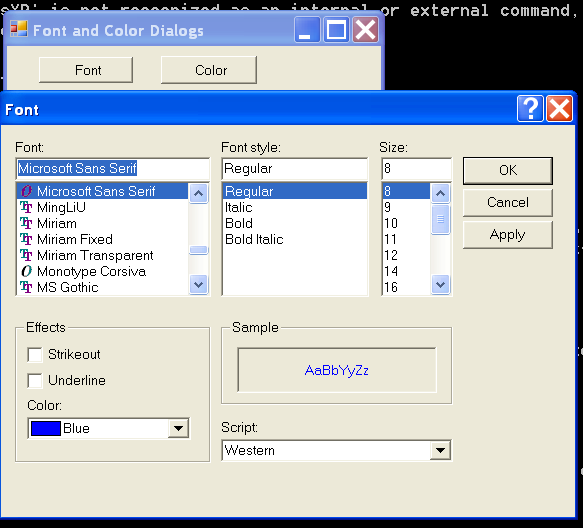Color Dialog and Font Dialog

/*
Professional Windows GUI Programming Using C#
by Jay Glynn, Csaba Torok, Richard Conway, Wahid Choudhury,
Zach Greenvoss, Shripad Kulkarni, Neil Whitlow
Publisher: Peer Information
ISBN: 1861007663
*/
using System;
using System.Drawing;
using System.Collections;
using System.ComponentModel;
using System.Windows.Forms;
using System.Data;
namespace ColorFontDialog
{
/// <summary>
/// Summary description for ColorFontDialog.
/// </summary>
public class ColorFontDialog : System.Windows.Forms.Form
{
private System.Windows.Forms.Button button1;
private System.Windows.Forms.Button button2;
private System.Windows.Forms.Label label1;
/// <summary>
/// Required designer variable.
/// </summary>
private System.ComponentModel.Container components = null;
public ColorFontDialog()
{
//
// Required for Windows Form Designer support
//
InitializeComponent();
this.Text = "Font and Color Dialogs";
this.button1.Text = "&Font";
this.button2.Text = "&Color";
this.label1.Text = "Change my FONT and COLOR!";
//
// TODO: Add any constructor code after InitializeComponent call
//
}
/// <summary>
/// Clean up any resources being used.
/// </summary>
protected override void Dispose( bool disposing )
{
if( disposing )
{
if (components != null)
{
components.Dispose();
}
}
base.Dispose( disposing );
}
#region Windows Form Designer generated code
/// <summary>
/// Required method for Designer support - do not modify
/// the contents of this method with the code editor.
/// </summary>
private void InitializeComponent()
{
this.button1 = new System.Windows.Forms.Button();
this.button2 = new System.Windows.Forms.Button();
this.label1 = new System.Windows.Forms.Label();
this.SuspendLayout();
//
// button1
//
this.button1.Location = new System.Drawing.Point(24, 8);
this.button1.Name = "button1";
this.button1.TabIndex = 0;
this.button1.Text = "button1";
this.button1.Click += new System.EventHandler(this.button1_Click_1);
//
// button2
//
this.button2.Location = new System.Drawing.Point(120, 8);
this.button2.Name = "button2";
this.button2.TabIndex = 1;
this.button2.Text = "button2";
this.button2.Click += new System.EventHandler(this.button2_Click);
//
// label1
//
this.label1.Location = new System.Drawing.Point(8, 48);
this.label1.Name = "label1";
this.label1.Size = new System.Drawing.Size(280, 48);
this.label1.TabIndex = 2;
this.label1.Text = "label1";
//
// ColorFontDialog
//
this.AutoScaleBaseSize = new System.Drawing.Size(5, 13);
this.ClientSize = new System.Drawing.Size(292, 101);
this.Controls.AddRange(new System.Windows.Forms.Control[] {
this.label1,
this.button2,
this.button1});
this.Name = "ColorFontDialog";
this.Text = "ColorFontDialog";
this.ResumeLayout(false);
}
#endregion
/// <summary>
/// The main entry point for the application.
/// </summary>
[STAThread]
static void Main()
{
Application.Run(new ColorFontDialog());
}
private void button2_Click(object sender, System.EventArgs e)
{
ColorDialog cd = new ColorDialog();
cd.AllowFullOpen = true; // allow custom colors
//cd.FullOpen = true; // shows custom colors automatically
cd.Color = Color.DarkBlue; // sets the custom color
//cd.Color = Color.Blue; // set the basic color
if(cd.ShowDialog() == System.Windows.Forms.DialogResult.OK)
this.label1.ForeColor = cd.Color;
}
private void button1_Click_1(object sender, System.EventArgs e)
{
FontDialog fd = new FontDialog();
fd.ShowColor = true;
fd.Color = Color.Blue;
fd.ShowApply = true; // ColorDialog does not provide this option!!!
fd.Apply += new EventHandler(ApplyFont);
if(fd.ShowDialog() != System.Windows.Forms.DialogResult.Cancel)
ChangeFont(fd);
}
private void ApplyFont(object o, EventArgs ea)
{
ChangeFont((FontDialog)o);
}
private void ChangeFont(FontDialog fd)
{
this.label1.Font = fd.Font;
this.label1.ForeColor = fd.Color;
}
}
}
Related examples in the same category